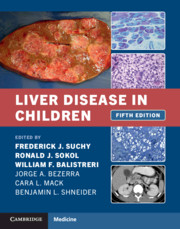Book contents
- Liver Disease in Children
- Liver Disease in Children
- Copyright page
- Contents
- Contributors
- Preface
- Section I Pathophysiology of Pediatric Liver Disease
- Section II Cholestatic Liver Disease
- Section III Hepatitis and Immune Disorders
- Chapter 17 Hepatitis A and Hepatitis E Virus in Children
- Chapter 18 Hepatitis B Virus Infection in Children
- Chapter 19 Hepatitis C Virus Infection in Children
- Chapter 20 Autoimmune Hepatitis in Children
- Chapter 21 Sclerosing Cholangitis in Children
- Chapter 22 Drug-Induced Liver Disease in Children
- Chapter 23 Liver Disease in Immunodeficiencies in Children
- Section IV Metabolic Liver Disease
- Section V Other Considerations and Issues in Pediatric Hepatology
- Index
- References
Chapter 20 - Autoimmune Hepatitis in Children
from Section III - Hepatitis and Immune Disorders
Published online by Cambridge University Press: 19 January 2021
- Liver Disease in Children
- Liver Disease in Children
- Copyright page
- Contents
- Contributors
- Preface
- Section I Pathophysiology of Pediatric Liver Disease
- Section II Cholestatic Liver Disease
- Section III Hepatitis and Immune Disorders
- Chapter 17 Hepatitis A and Hepatitis E Virus in Children
- Chapter 18 Hepatitis B Virus Infection in Children
- Chapter 19 Hepatitis C Virus Infection in Children
- Chapter 20 Autoimmune Hepatitis in Children
- Chapter 21 Sclerosing Cholangitis in Children
- Chapter 22 Drug-Induced Liver Disease in Children
- Chapter 23 Liver Disease in Immunodeficiencies in Children
- Section IV Metabolic Liver Disease
- Section V Other Considerations and Issues in Pediatric Hepatology
- Index
- References
Summary
Autoimmune hepatitis (AIH) is a progressive inflammatory disorder of unknown etiology, characterized histologically by interface hepatitis, serologically by the presence of non-organ specific autoantibodies, biochemically by elevated aminotransferases and serum IgG, and clinically by response to immunosuppressive treatment in the absence of other known causes of liver disease [1].
- Type
- Chapter
- Information
- Liver Disease in Children , pp. 321 - 332Publisher: Cambridge University PressPrint publication year: 2021
References
- 2
- Cited by

